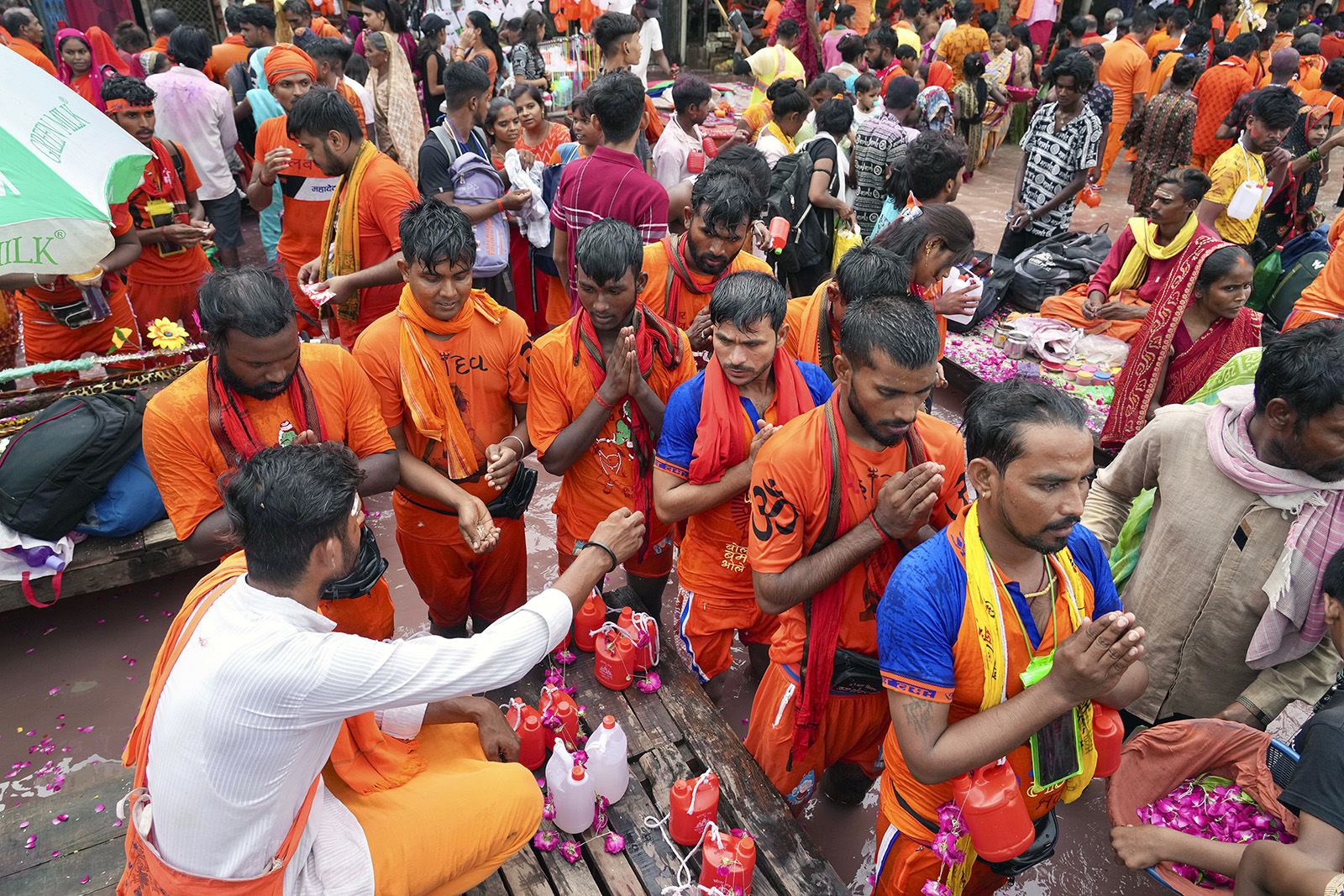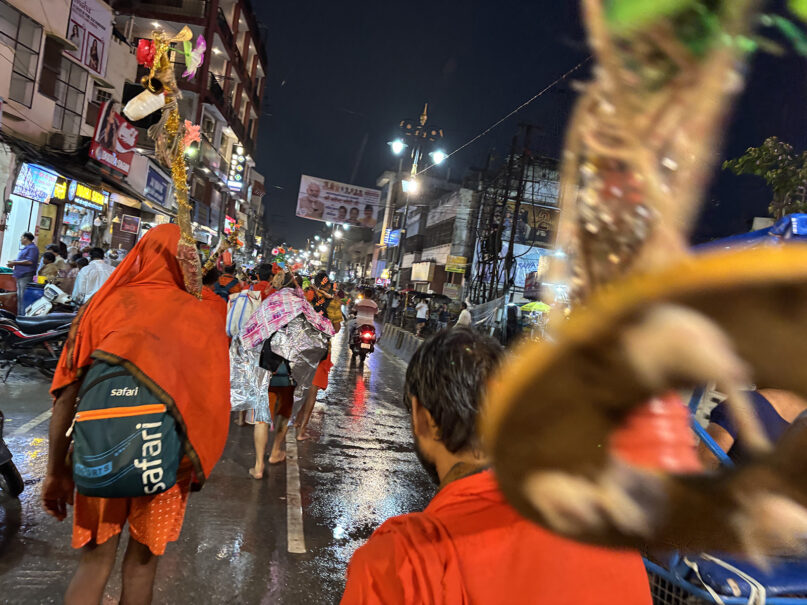
NEW DELHI (RNS) — The highways leading east out of India’s national capital, typically fast-moving commuter routes, slowed to a crawl this week as a saffron wave of young men in orange robes walked steadily, bamboo poles balanced on their shoulders hung with pitchers full of water collected from the sacred Ganges River.
These men are participating in Kanwar Yatra — a centuries-old pilgrimage that takes place during the monsoon month of Shravan. They walk for days, traveling 100-500 kilometers, to fetch water from the sacred cities of Haridwar, Varanasi or Baidnath to pour on lingams, or icons, of the Hindu deity Shiva in their hometowns and villages.
In recent years, the pilgrimage has seen a sharp surge in popularity, with some 40 million taking part last year; this year, that number is expected to rise to 60 million before the festival concludes Saturday (Aug. 9).
With the growing numbers of celebrants, Kanwar Yatra has increasingly become not just a spiritual affair but a showpiece for Prime Minister Narendra Modi’s politics of Hindu nationalism. Several state governments headed by members of Modi’s ruling party, the BJP, have rerouted highways, axed trees and shut down schools, all while ramping up security. In some places, petals have been dropped from helicopters.
With the signals of government support, too, have come another hallmark of Hindu nationalism: violence aimed at excluding non-Hindus from the festival.
On July 8, along the 150-mile route from Delhi to Haridwar, a group of young male worshippers, known as kanwariyas, vandalized a roadside eatery after they were allegedly served onions — triggering objections linked to notions of ritual purity. In the city of Ghaziabad, vigilante groups targeted a KFC and a local restaurant for serving nonvegetarian food.

Kanwariyas walk on the street through Varanasi, in the northern state of Uttar Pradesh, India, July 23, 2025, during the annual Kanwar Yatra Hindu pilgrimage. (Photo by Anuj Behal)
On July 10, 2025, Delhi’s Culture and Tourism Minister announced that all butcher shops along the Yatra route would be shut from July 11, citing “respect for devotees’ sentiments” — in effect enforcing Hindu reverence for cattle. While the Municipal Corporation of Delhi later clarified that the announcement was not a directive but an appeal for consideration, Mohd Nazir, a butcher in Delhi’s Indirapuram neigborhood, said he knew better. “There was no mandatory order from the government this year, but I’ve been closing my shop for four years now,” he said.
Apoorvanand Jha, a professor at Delhi University, said the campaign against meat sales during the pilgrimage targets more than just dietary preferences. “By discouraging meat sales, there’s a veiled attempt to frame a certain community — largely Muslim— or at least a way of living that is viewed as impure. The Kanwar Yatra becomes a platform to exercise a kind of violence that wouldn’t otherwise be permissible,” he said.
Since taking office in 2017, Uttar Pradesh Chief Minister Yogi Adityanath, a saffron-robed monk, has turned the Kanwar Yatra into a platform to advance the regime’s Hindutva agenda across Uttar Pradesh. He has repeatedly declared that any attempt to “defame, disrupt, or malign” the Kanwar Yatra will not be tolerated.
This aggressive posture appears to have translated into policing on the ground. In one case, a public school teacher in Uttar Pradesh was arrested after a video showed him reciting a poem he’d written at a morning assembly. “Don’t go to fetch the Kanwar,” the poem said, “light the lamp of knowledge …”
Last year, eateries along the Kanwar Yatra route in Uttar Pradesh were required to display the names of their owners. The move was intended, authorities said, to “maintain the purity of faith” of the Kanwar pilgrims, but the underlying message was clear: Steer clear of Muslim-run businesses.

Hindu pilgrims, known as kanwariyas, walk on the banks of the Ganges River in Prayagraj, India, July 2, 2023. (AP Photo/Rajesh Kumar Singh)
This year, the state introduced QR codes that reveal the name, food license, address, menu and hygiene ratings of every shop. Officials describe it as a food safety and transparency measure, but critics like Jha see it as a digital version of last year’s nameplate diktat. “In the language of technology, this is yet another tool to create an environment of exclusion,” said Jha, who has filed a court petition challenging the practice.
Shubham Rajput, a kanwariya on his way to Haridwar, said such identification measures are necessary. “These Muslims eat beef and are impure — forget onion or garlic. What if they spit in our food just to defile it? This way, we can choose not to eat from them,” he said.
As the pilgrimage has become politicized, the celebration of the Kanwar Yatra has undergone a dramatic transformation. Devotional chants have been replaced by blaring music laced with Hindutva overtones, and the religious iconography of Lord Shiva is now intermingled with symbols of state oppression — most notably the bulldozer, which has come to signify the demolition of Muslim homes.
This tacit endorsement of the state has appeared to empower kanwariyas to assert religious dominance. “It becomes a veiled way to target a particular community — primarily Muslims — and to exercise majoritarian supremacy. The Kanwar Yatra hence becomes a platform to exercise a kind of violence that wouldn’t otherwise be permissible,” said Jha.
Mob violence has also broken out over any disrespect shown to the bamboo poles, or kanwar, that are so sacred that even accidental contact is deemed a violation. This logic entitles pilgrims to respond with fury, which is then rebranded as devotion. On July 11, in Roorkee town, an SUV was damaged and its driver assaulted by a group of kanwariyas after the vehicle touched the kanwar. On the same day in Muzaffarnagar, Kanwariyas beat a man when his motorcycle accidentally brushed their kanwar.
But it doesn’t take much to spark violence. Videos circulating online show pilgrims smashing shopfronts over minor disputes and attacking paramilitary troops, law enforcement officers and volunteers attempting to keep the peace. So far this year, more than 170 cases of violence and disorder have been registered against kanwariyas. Hockey sticks and tridents have been banned on Kanwar Yatra routes to prevent clashes.
Warnings to pilgrims to refrain from violence, meanwhile, are rare. Despite the deployment of more than 60,000 police and paramilitary personnel, including 10,000 women officers, for this year’s yatra, a senior police officer in Haridwar admitted, “It’s an emotionally charged crowd — we can’t afford to provoke them. They could simply turn on us.”
Another official, requesting anonymity, added, “I don’t even think the politicians would want to see action taken against them.”
Kanwariyas now no longer appear as humble devotees — but as state-sanctioned emissaries. “Their violence is labeled devotion,” said Jha. “The regime has instilled in Hindus the belief that the road is yours, the city is yours — you can behave as you wish. Because the government is with you, and the government is made of you.”
